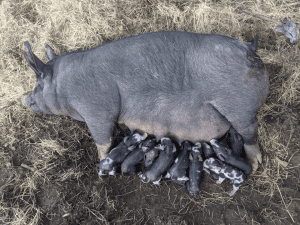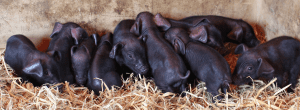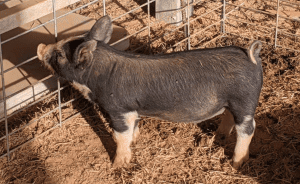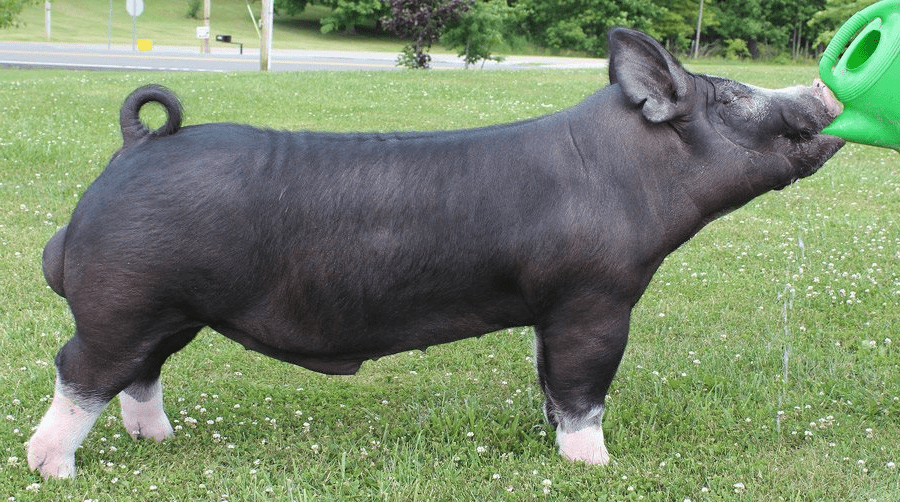One of the oldest breeds of swine, black Berkshire pigs go back at least 350 years in history. The quality of the marbled meat that the Berkshire can provide for your homestead is unmatched. If you need a hardy and intelligent pig to provide meat for your homestead operation, the Berkshire may be perfect for your needs.
Berkshire Pig Origin
Berkshire pigs are native to England. They are named for the area in which they originated, the “shire of Berks.” In the early 1800s, pig breeders brought the Berkshire to the United States. A breed registry was formed in 1875.
These pigs are considered lard pigs because they make large deposits of fat in their bodies. In the 1800s and early 1900s, people used lard often for cooking.
However, after World War II, people gradually reduced their use of lard, and the Berkshire pig fell out of favor. Numbers fell to all-time lows in the late 1900s. However, because of the increased interest in heritage foods, the Berkshire is currently increasing in popularity.
Berkshire Pigs Appearance
While the original pigs were sandy brown, modern Berkshire pigs are mostly black to charcoal gray in color. They are often considered to be black pigs. However, they have white “points.” That is, they often have white legs, tails, and faces. Their skins are pink.
The Berkshire pig has short ears that are erect and forward facing. They also have slightly dished faces and relatively short, upturned snouts. Their legs are rather short in comparison to the rest of their bodies
The Berkshire is considered a medium-sized pig. The females, called sows, weigh about 400 pounds at maturity while the males, called boars, tip the scales at around 600 pounds.
Benefits of Berkshire Pigs
Berkshire pigs are intelligent and friendly. Because of this, they are quite satisfying to raise. The pigs will quickly learn the feeding routine and be waiting for the farmer in the designated feeding area. They are a fairly docile breed and will do well when raised in a mixed swine herd.
Like most pigs, raising Berkshires is fairly simple. They need food, shelter, and plenty of water. You do not have to get a sow and a boar if you want to raise Berkshires. You can just buy weaned piglets and raise them as Berkshire feeder pigs, selling the meat when they reach slaughter weight.
Berkshire sows are excellent mothers. They have plenty of milk for raising their piglets. They are attentive to their broods and care for them well. In addition, they are also docile. This means you won’t have as many safety worries when you have a litter of piglets.

While pigs can be a bit sensitive to sunlight, Berkshires have an advantage over lighter colored pigs in that their black hair protects them against sunburn. This makes the Berkshire a good breed choice for warmer climates.
Because Berkshires are so intelligent, they are a perfect breed for pasture raised pork. They will find the best spots in the pasture for tasty roots and weeds. They also will stand up against predators.
Like all pig breeds, their intelligence also makes them great pets. You can easily train your Berkshire pig. However, you should never try to make an intact (uncastrated) male pig into a pet. The male hormones can make these animals unpredictable and aggressive.
Berkshires live up to ten years. Their expected lifespans are between 6 and 10 years. However, boars may need to be replaced after about 4 years of age. After that point they may be too large to breed young sows without injuring the sow.

Berkshire Meat
While the Berkshire is labeled as a lard pig, there is much more going for this kind of pork than just the lard. The meat is perfectly marbled, providing for an unusual dining experience.
Professional chefs as well as individual consumers have come to love the intense flavor that Berkshire meat provides. In Japan, Berkshire pork is seen as a delicacy. It is called “Kurobuta” in Japan.
The meat of a Berkshire pig is loaded with flavor. While commercially raised pork can be dry, tasteless, and unappealing, Berkshire pork is totally different. The meat is pink and juicy. It has tons of flavor. Some lard pigs deposit the fat in a rim around the muscle tissue. Berkshires deposit the fat throughout the muscle, giving delicate marbling to each piece of meat.
If you have the space, raising small groups of market pigs can be a low-investment and short-term project for families. When done the right way, it’s a way of saving money on pork as well as having a reliable meat source. With the cuts of meat available from the pig at harvest, Berkshire pigs are a good choice.
Understanding the cuts of pork and how much you need for your family and/or to sell, will determine how many to raise in your small herd of pigs. You can also check out Berkshire pork prices for pound in your area compared to other pig breeds.
Raising Berkshire Pork for Meat
Berkshire pork is different from commercially raised pork. The flavor is more intense, and it is moist and tender. Some people call Berkshire pork the “Kobe beef” of the pork world because it is so distinctive in its quality.
While industrially raised pigs are given a diet that consists mostly of corn and soybeans, many homesteaders raise their pigs on other things. Of course, the saying “you are what you eat” applies even to pigs. Pigs given a wider variety of food items to consume will yield more flavorful pork.
If you can find a feed supplier that combines wheat, peas, soybeans, corn, and oats, your Berkshire pork will have more flavor. Additionally, pasture raised pork tastes better too. The pigs in a pasture will find grubs, roots, and weeds to add to their diets. You can also feed pigs all kinds of scraps from the kitchen.
On average, Berkshire hogs will consume between 6 and 7 pounds of feed per day between weaning and slaughter. You can fatten both castrated boars, also called barrows, and gilts. In general, when raising Berkshire feeder pigs, the gilts are slower to grow but have greater feed efficiency. This means that the females experience more growth per pound of food. However, if you are in a rush to get pigs to market, the barrows are faster at growing.
From birth to when a Berkshire hog reaches a market weight of about 250 pounds takes between 180 and 195 days. They typically gain about 1.35 pounds of weight per day.

Reproduction
Gilts, or young female pigs, reach sexual maturity around six months of age. However, it is best to give her a few more months to grow before you allow her to breed. Keep young gilts away from intact males until they are around nine months old to prevent them from breeding too young.
You want the gilt to be about 100 pounds before you allow her to become pregnant.
Sows and gilts come in heat about every three weeks until they are bred. Gilts should be bred on the second or third heat after they reach puberty to ensure maximum fertility. Generally, in early puberty, gilts experience increased ovulation. It makes sense to allow her to breed in this time for larger, healthier litters
Boars, or male pigs, reach sexual maturity around five or six months of age. However, he should not be used for breeding at this point. He will need to grow a bit taller so that he can service the mature sows. When the boar is nine to ten months old, he will be ready to breed with the females.
For every 18 to 20 sows, farmers should have one boar. He should not be used to breed sows more than five times per week.

Boars should be kept apart from the females. The females should be brought to the boar to avoid fighting and injury to the stock. Young boars need to gain confidence in breeding. If they are young and the older, larger sows are permitted to intimidate him, the boar may never be able to recover his confidence and breed your sows.
For a first mating, boars need to be placed with a young, docile female.
Boars and sows should be put together first thing in the morning before feeding, especially if the weather is hot. Boars are generally more active in the mornings.
Many farmers wait 12 hours and put the sow in with the boar once again to ensure that she is bred. One does not have to use a boar. Artificial insemination is quite common in raising pigs.
Gestation
Pregnant Berkshire sows carry their piglets just a bit longer than many other breeds of pigs. Berkshire sows are pregnant about 116 days. On average, Berkshire gilts and sows have litters of about 8 to 10 Berkshire piglets.
If all goes well, a sow can farrow, or give birth, to two litters of pigs each year. Piglets are weaned around eight weeks of age.
Some farmers only allow their sows to have one litter per year, particularly if the pigs are living outdoors and harsh summer or winter weather is to be avoided. How long are pigs pregnant
Housing and Fencing Needs
In recent years, many consumers have begun to pay closer attention to how the animals that provide food are raised. Many consumers desire that the pigs that provide pork for their tables live a natural life.
Additionally, the increase of illnesses in animals that are raised in confinement means that many producers are changing the way that they raise animals. You may be able to market pork raised outdoors to specialty markets and those who want humanely raised meat.
Berkshire pigs are excellent choices for raising on pasture. They are smart, and they will quickly learn the limits of their pen.
As far as what do pigs eat, Berkshires will find roots, nuts, acorns, berries, grubs, and weeds to supplement the ration that you provide for them. However, you must have them properly fenced, or they will escape.
An electric fencing wire that is six to eight inches from the ground will keep the pigs from rooting up your fences and escaping underneath the wires. Check the electric fencing regularly because the pigs will root near the fences and possibly be able to ground out the hot wire with humps of dirt.
Pastured pigs should be stocked at a rate of 25 pigs per acre. This means that on a quarter acre lot, you can have about 6 – 8 pigs.
The pigs will need a hut or shelter from the elements when on pasture. This does not have to be fancy. Often in warmer months, homesteaders will provide portable huts for the pigs so that the pigs can be rotated through different pastures. A tractor or ATV can be used to move the huts.
If you are using a space for farrowing, the needs for shelter are different. Very young piglets need a consistent temperature of 85 to 90 degrees Fahrenheit, so your shelter will need to be heated.
In the warmer months, you may need to cool your farrowing shed. Ventilation for indoor areas is crucial to keep the pigs from overheating. Areas for piglets should be warm and dry.
Many people raise their pigs in confinement. While this is not ideal, Berkshires seem to do well. Hoop houses are often used to house Berkshires on pasture in confinement.
For growing piglets indoors, you need to plan for about 8 square feet per animal. For adult animals, while you can raise them in spaces as small as 5 to 10 square feet per animal, it is definitely not best.
If you increase your space to 20 square feet your pigs will gain weight more quickly and be happier.
Berkshire Pig Characteristics
Like all pigs, Berkshire pigs are social animals. They do best when they have the company of other pigs. You should have at least two pigs to keep them happy. Happy pigs will be less likely to try to escape.
Berkshire pigs are also very intelligent and have long memories. This can be a good thing, since they will remember the pain of touching the electric fencing. They will then avoid repeating the action.
However, if you have a bad interaction with the pigs, they will never forget it. This means that you will have to consistently practice careful, gentle handling of your Berkshires, so they don’t come to consider you as their enemy.
Like all boars, Berkshire boars have the potential to be dangerous. If you plan on keeping a boar instead of performing artificial insemination, you must handle him carefully. Keep him within sight of the other pigs, so he will not feel lonely.
His pen should be very sturdy. Bring sows to the boar instead of trying to move the boar into the sow pen.
Additionally, the performance of your boar can be affected by extreme temperatures. If he gets too hot, his sperm counts will be low for up to 2 months. You may want to provide fans and plenty of water for him to lay in if you live in a place that gets hot in the summer.
Fun Fact
Breeders wanted to create a true grazing pig rather one who roots. Most pigs root because they have long snouts which makes it difficult for them to graze on grasses and legumes when on pasture.
Combining traits from the Berkshire pig, Kunekunes, and Durocs created a new pig breed called Idaho Pasture pigs. These have the smaller, shorter snouts and graze rather than root up pasture.
Lard Pigs
With large deposits of fat in their bodies, this heritage breed pig is used for meat and lard. The humble Berkshire is once again on the rebound. Consider finding Berkshire pigs for sale and adding them to your small farm.
Berkshire sows make excellent mothers and have easy-going temperaments. Breeding pigs can provide a good return on investment.
Raise pigs so they can have time outdoors in the fresh air, free range and exploring. It will keeps them happy and healthy and provide you with quality, flavorful marbled pork.
In addition to Berkshire pigs for their delicious pork, consider additional pig breeds for your backyard farm to meet your needs:
- Hampshire pig ~ Raising a Meat Source on Your Farm
- Mangalitsa pig

